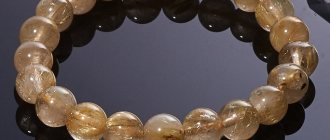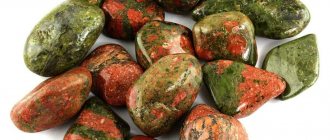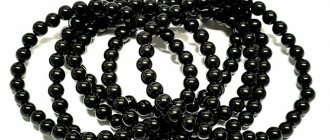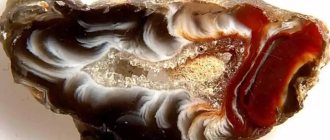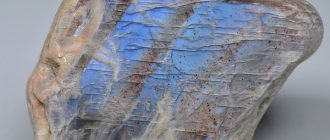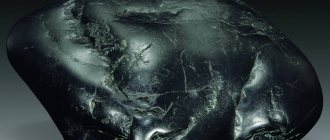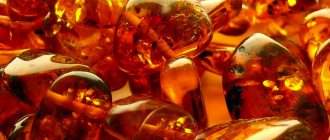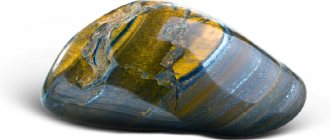Labradorite is a precious natural mineral with mystical properties and incredible external beauty. Labradorite stone is a real miracle, created by nature and shrouded in many myths and legends. So, according to one of them, the stone appeared thanks to an unknown witch who cast a spell and turned moonlight into crystals with unique beauty and magical powers. Indeed, the mysterious mineral is mesmerizing, because it shimmers with emerald, blue, purple, turquoise, green and gold colors. However, it truly demonstrates its uniqueness in the light of the sun’s rays - it shimmers with shades of the rainbow spectrum (this effect was called iridescence by scientists). It is thanks to the wide range of colors, bright patterns and mysterious reflections that the stone resembles a chameleon. In addition to its beauty, moonstone has inner strength and energy, healing and magical effects, and is also a symbol of spiritual harmony and tranquility. Today, Labradorite is in great demand among collectors, occultists, healers and beautiful girls.
History of the stone
The first mentions of the precious stone originate from legends, myths and various traditions. Let's look at some of them:
- There is information that minerals similar in properties to labradorite originated in Ancient Greece and were known to Pliny the Elder. The Greeks believed that Labradorite possessed magical powers that could heal and save a worthy person, whose thoughts and beliefs were unchanging and pure, from various misfortunes.
- In Medieval Rus', gems were called tausin (from the Persian “tavusi” - peacock). They were used to decorate temples.
- The magical breed was discovered by the Indians and Vikings, who considered the Labradorite stone to be the guardian of the family hearth and a protector from infidelity and marital betrayal. However, the rock still did not receive serious recognition among the tribes; it had no practical use in everyday life.
- At the end of the 18th century, on the largest peninsula of Labrador (Canada), archaeologists again found labradorite - this served as the official discovery of the precious rock. An important role in the study of the so-called moonstone was played by the German scientist A. Gottlieb Werner, who conducted his own analysis of the rock and described in detail its physical and chemical characteristics. In 1780, the mineral was named after the location of the Canadian deposit - Labradorite. Almost instantly the stone became popular and was actively used by jewelers and artisans. As a result of this study, labradorite became important in mineralogy, which prompted continued searches for its deposits on other continents. Today it is found in Canada, the USA, Brazil, Madagascar, Ukraine, Finland, Australia, Mexico
- Mikhail Pylyaev in his work “Precious Stones” mentions a boulder found near the Kalinkin Bridge containing spectrolite, which was bought by the Duke of Devonshire for one thousand banknotes.
Branches of application of Labradorite
Despite the fact that labradorite has been known to mankind for a very long time, it began to be widely used only in the 19th century, after the discovery of large deposits in Russia and Ukraine. Since then, the stone has been actively used in construction and facing works.
It is also popular today as an ornamental and jewelry gem; rings, bracelets, earrings, necklaces, cufflinks are decorated with labradorite inserts; figurines and souvenirs are carved from the stone.
Physico-chemical characteristics
Labradorite is a coarse or medium-grained crystalline rock, a type of gabbronorite, approximately 60% consisting of calcium plagioclase - labradorite with an admixture of pyroxenes and ore inclusions.
Physical properties of labradorite stone:
- consists of 49-69% CaAl2Si2O8 and 35-55% NaAlSi3O8, containing small impurities of Fe, K, Mg;
- crystal shape: columnar, thick-tabular;
- acidity – SiO2 45-52%;
- color – black with a blue tint, brown with a golden and reddish tint, blue, aquamarine, green with iridescent tints, gray, etc.;
- density is 2.69 – 2.70 g/cm3;
- opaque;
- hardness 6 – 6.5 (Mooca scale);
- the average crystal size is 5-10 centimeters;
- crumbles when squeezed, fragile;
Labradorite - a mysterious stone from legend
In 1770, extravagant Europe, during the heyday of the Rococo era, captivated people with an unusual stone brought from North America from the Labrador Peninsula. The stone became very fashionable among aristocrats, the richest people of that time, as well as among all kinds of magicians and psychics. It was believed to have miraculous properties. Labradorite, as this miraculous mineral was later named, attracted attention with its bright rainbow tints. Now we call this effect iridescence. The reason for its appearance remained a mystery for a long time. Only studies using an electron microscope made it possible to find out that Labradorite consists of the thinnest plates, slightly different in composition. The interaction of light waves reflected from different plates leads to the appearance of bright, spectrally pure colors.
In those distant times, they wore a lot of jewelry and with pleasure. They embroidered men's and women's clothing, decorated fans and snuff boxes. An object unfamiliar to us - a flea trap box, in beautiful ornaments, was also strewn with diamonds and all kinds of precious stones. Yes, I must admit, they didn’t like to wash in Europe. At court they often scratched themselves and smelled strongly of perfume. Why the French invented perfume, one can only guess.
Flea trap box, 18th century.
That's how they wore it.
The flea trap box could have very bizarre shapes...
(Sorry for going off topic.)
Labradors with blue, purple, yellow and green tints were inserted into rings, brooches, and earrings. Bracelets and necklaces (chokers) were made with these stones. A properly processed stone was mesmerizing, flashing with bright colors when the light hit its surface.
Labradorite is a calcium-sodium plagioclase feldspar, intermediate in composition between albite Na [AlSi3O8] and anorthite Ca [Ai2Si2O8]. A rock composed predominantly of this mineral is called labradorite. Hardness on the Mohs scale is 6, which is quite enough to use the stone for ornamental work. The average specific gravity is 2.7 g/cm3, density is 2.69-2.70 g/cm3. It contains 3.96% magnesium oxide, 10.93% calcium oxide, 26.83% aluminum oxide and 55.49% silicon oxide. Iron, potassium and magnesium are characteristic impurities. Labradorite formations are represented by dense, coarse-crystalline masses. Sometimes small crystals are found. having a prismatic structure. Labradorite is a mineral of igneous origin. Formed in basalt voids. The mineral's satellites are magnetite, olivine, pyroxene, and pyrrhotite.
All known types of labradorites can be divided into:
1. Spectrolite - shimmers with all the colors of the rainbow.
2. Black moonstone is a dark-colored mineral with blue or light blue iridescence.
3. Sunstone - light orange with golden iridescence. Found only in the USA, Oregon.
4. Bull's eye - shimmers with red-brown shades, the stone itself is violet-brown.
5. Lynx eye - differs from a bull eye in its characteristic green reflection.
6. Aventurine Labradorite - golden shimmer. The presence of copper and magnetite creates a shimmering effect.
7. Tavusit - can be compared to the shimmer of peacock feathers.
A few years later, after Europe became acquainted with the new mineral, in Russia, in the fall of 1781, under granite fragments that were used to improve the road from St. Petersburg to the royal pleasure palace in Peterhof, a significant mass, almost entirely consisting of feldspar, was found to North American raw labradorite stone. It was the construction of the road that helped discover the stone on the territory of our country and this was the first deposit in Europe. The news that an overseas gem was lying right on the road near the Russian capital created a sensation.
In the famous book of 1789 “The First Foundations of Mineralogy”, author V.M. Severgin describes the find this way: “Labrador, blueberry, iris. The color is always almost light gray, dark gray, black-gray, but in different directions it mostly shines with very bright variegated colors, such as azure, blue, different shades of green, sometimes lemon, and a color that is in the middle between copper and tambaco, and sometimes issera-violet...rarely do these flowers extend over the entire piece, but are usually visible only in places..."
After the discovery of the deposit, there was a new round of popularity and increased interest in Labrador. He began to be present wherever possible. The ladies of the court wore all kinds of jewelry and even dresses that resembled him in color. The stone was widely used for finishing and decorating palaces. Interior items were made from labradorite: snuff boxes, tabletops, inkwells, vases and other things dear to the heart.
The eyes sparkling with all shades of peacock feathers seem to be inlaid into dark rock. Moreover, these overflows appear only with proper processing and skillful polishing. Sometimes, flashes of color can be seen on a wet stone. If you twirl a polished piece of labradorite in your hands, some eyes will flash and others will go out. Sometimes on a labradorite slab measuring 1 square meter, you can count 200-300 iridescent eyes. Successfully crafted eyes could cost more than diamonds. Let’s say an insert for a ring in the capital could cost from 25 to 100 rubles, a snuff box from 500 to 1500 rubles.
In the 19th century, another rich deposit was found on the territory of Ukraine. In 1835, the world's richest deposits of labradorite, or as it was called in Russia, “ peacock stone,” . It turned out that entire rock masses not far from Zhitomir are composed of fashionable and expensive gemstones. They occupy an area of up to 1000 square meters. km. There are places in the Zhytomyr region where the beauty of stone is available to everyone. The small river Irsha in some places polished the stone so that blue-green sparks are visible in the black rocks from afar.
Currently, labradorite is mined in Yakutia, Buryatia, Krasnodar and Khabarovsk territories. Mining is still underway in eastern Canada - the Labrador Peninsula and the Greenville Mines. Single deposits have been found in Finland, India, Greenland, and Tibet. Rare gem-quality minerals are mined in Australia. Spectrolites are found in only one place on earth: the vicinity of the Finnish city of Ylämaa.
It is interesting that the “peacock stone” survived oblivion on our land, and more than once. How and why they completely forgot about him is unknown. Our distant ancestors from the times of Kievan Rus used it in architecture. Its blue crystals were used in mosaics for the interior decoration of churches. The excess stone was sold to the East, where it was called tausin (from the Arabic word “taus” - peacock).
The discovery of a deposit in Ukraine has greatly reduced the price of Labradorite. From a precious stone it has turned into a fairly affordable finishing material. It can be seen on city streets in the lining of fountains and columns. But this does not at all detract from its merits and beauty. Labrador has a very ancient history and its connection with the ancient peoples who inhabited our planet is very long.
A number of scientists and archaeologists have been trying to find the ancestral home of humanity for several decades. In Yakutia, back in the 80s of the 19th century, excavations were carried out on the territory of the Lena Pillars natural park and sensational archaeological discoveries were made.
Lena Pillars National Park is one of the natural wonders of Yakutia.
The reserve covers an area of about 500 hectares.
The Lena Pillars reserve is included in the UNESCO heritage list.
Along the banks of the Lena River, relict rocks stretch for tens of kilometers.
These regions can tell a lot about the history of mankind. In 1982, archaeologist Yuri Molchanov discovered the ancient site of Diring Yuryakh in the park.
The age of the finds is determined by scientists in the range from 3 to 2 million years. This fully confirms the version of a number of modern scientists that one of the centers of the origin of humanity was located in the northern territories of what is now Russia. Which forces the scientific world to seriously reconsider the concept of the origin of humanity in East Africa. Already in August 1988, the All-Union Conference “The Problem of the Ancient Homeland of Humanity in the Light of New Archaeological Discoveries” was held there in Yakutia. The scientists' conclusion was clear. Research is not only a national, but also a universal, planetary asset. The very presence of this focus of protoculture is consistent with geological data on the existence of a large continent in the area of the current north pole. As well as the Avestan and Vedic epics, according to which there was an ancient paracivilization in the North that sank to the bottom of the Arctic Ocean as a result of a global natural disaster.
The word “Hyperborea” was first mentioned in the works of ancient Greek researchers. From the ancient Greek Hyperborea is translated as “beyond Boreas,” beyond the north wind. Pliny the Elder wrote about the Hyperboreans as a real people, without any mythological background. The map of the famous 16th century cartographer Gerardus Mercator (1512-1594), where he allegedly first showed Hyperborea in the North Pole region, created a lot of noise in scientific circles and continues to excite the minds of researchers to this day.
Blavatsky and the Roerichs, as well as other esotericists, including the ideologists of the Annenerbe, later wrote about ancient Hyperborea. They all agreed that Hyperborea was one of the most ancient civilizations on Earth, if not the most ancient. The descendants of which later populated the territories of the Urals, Siberia and Northern Europe. Nostradamus, in his “Centuries,” called the Russian people Hyperborean. There is no doubt that ancient Hyperborea is directly related to the history of Russia.
According to one legend, it was the Hyperboreans who first discovered and appreciated the stones that are now familiar to us under the name Labradorite. They valued this stone not only for its unexpected splashes of color and deep shades, appearing as if from within the mineral itself, but also for properties about which we know little. It is believed that the Hyperboreans had abilities and knowledge about which our civilization today has no idea. They lived in harmony with nature, knew its characteristics, understood its laws and felt the inextricable connection of times. The stone with blue-green tints was a friend and assistant in all matters for the inhabitants of Hyperborea. They agreed with him, they listened to him, he was held in special esteem among other stones and objects. This was no ordinary stone. He had his own character and not everyone could have it. The Hyperboreans themselves, in order to test a person, could give him jewelry with a stone that was impossible to refuse. And the stone decided to accept the person as its owner, or to reject it. If a person had good qualities - the stone was devoted to him and directed him on the right path, he could adjust the owner’s thinking in such a way that he himself found a solution from a seemingly hopeless situation. Immoral and weak people could not stand the test of the stone; it could even harm them.
Labradorite stones are usually divided by gender into male and female. Men's stones include light, golden shades, while women's stones are darker green and blue. A pair of such opposite-sex stones attracts marital happiness and prosperity to the home. These can be uncut stones, stone figurines or decoration. There is an opinion among astrologers that the Labrador, as a watchdog, will not allow a stranger with bad intentions to enter the house and will ward off trouble.
This cute dog of the Labrador breed, with the stone, except for the name of the breed, nothing connects him, well, maybe only devotion and loyalty to the person. You need to tame him, make friends with him and accept him into your family. And the same with stone. Then he will serve you faithfully.
If you learned something new and the article seemed useful to you, click “like” and “add to favorites.”
Thank you for your attention.
Best wishes!
Where is Labradorite mined?
Labradorite is widely distributed in nature. The breed is represented in different areas of the world, but it differs from each other and has individual external characteristics.
The largest deposit is located in Canada.
In Russia, Labradorite stones predominate in Eastern Siberia. Peacock stone also occurs on the Kola Peninsula and Kamchatka. The main deposits in the post-Soviet space today are concentrated in the massifs in Volyn and the Dnieper region (Ukraine). There are 26 known deposits in these areas, 6 of which have been geologically studied and two are being developed.
Place of Birth
Canada and Ukraine are famous for the largest gem mining sites. In Russia, the mineral is mined in the Khabarovsk and Krasnoyarsk territories, Buryatia and Yakutia. The following states also have deposits of Labradorite:
- Mexico.
- Australia.
- India.
- USA.
- Brazil.
- Germany.
- Greenland.
- Burma.
- Mongolia.
The islands of Sri Lanka and Madagascar have the most beautiful examples with multi-colored iridescence. High-quality ornamental stone is found in Tibet. Unique specimens also come from Finland.
Also read: Moissanite - attracts good luck
Color and varieties of mineral
- Spectrolite is a valuable variety of Labradorite, shimmering with all shades of the spectrum. This sample, refracting sunlight, shimmers with rainbow colors, similar to the color of peacock feathers. They were officially discovered in the 40s of the last century, and the introduction of gems into the production of jewelry began after the end of World War II;
- black moonstone is a blue labradorite with iridescence with a blue or light blue tint. Mining is carried out mainly in Madagascar. Individual specimens are often compared to a starry night sky;
- tavusit - a variety that shimmers with bright colors and visually resembles the iridescence of the plumage of peacocks;
- Bull's Eye is a stone that has an asterism effect and exhibits rich white reflections on a brownish-honey background. Very rare in nature;
- Lynx eye is a bright green mineral found in the Middle Urals. It combines gray, green, metallic shades;
- sunstone is a unique crystal mined in Oregon (USA);
- belomorite is a very rare mineral of a hazy hue with silver reflections. A unique find for any geologist.
How to distinguish a fake?
Because of its beauty and mystical properties, the mineral is very valuable. This is why some dishonest sellers try to fake a gem and pass it off as real for the sake of monetary gain. However, the process of creating artificial labradorite stone is significantly more complicated due to the presence of glare, complex colors and various tints. Today it is impossible to produce Labradorite identical to the real thing. Artificial stones will still have significant differences from natural samples.
It’s easy to distinguish a real mineral from a fake:
- Labradorite seems to be illuminated from within when exposed to light. If you twist it in the sun and carefully examine the acquired gem, you will definitely see the effect of a three-dimensional northern lights, as if passing through the stone. The observed optical effect will confirm the authenticity of Labradorite;
- has extremely low thermal conductivity, therefore, pressing a stone to your cheek, it will not heat up, but plastic or glass will behave exactly the opposite;
- When purchasing a real Labradorite, you will be sure to receive a certificate that will indicate the originality of the gem. Today, unscrupulous sellers have learned to falsify supporting documents, so you should carefully study them for accuracy before purchasing. On fakes, they sometimes put the name of the imitation stone in quotation marks, or write “synthetic” in small print. In this way, scammers try to avoid prosecution if the buyer is accused of selling a fake stone.
Where is the stone used?
Decor
The physical characteristics of labradorite are similar to granite.
In this regard, classic samples of Labradorite are often used as a facing material for finishing buildings and interiors. For example, the black mourning frieze on the Lenin Mausoleum is made of labradorite. Labradorite is also used to make various figurines, beautiful vases, frames and stands, which look quite unusual and presentable; they are actively used in creating furniture or as an addition to its individual parts.
Labradorite jewelry
The most beautiful and unusual specimens make self-sufficient jewelry, such as pendants, earrings, bracelets, rings, etc. Labradorite is usually framed in silver or platinum, and in order to emphasize the external uniqueness of the stone, jewelers polish it with a cabochon. This way the iridescence appears more clearly. Particularly popular are massive necklaces using labradorite, which are perfect for an evening look. Exquisitely selected brooches will add a business style to your suit, while small earrings and simple bracelets are appropriate for everyday wear.
Jewelry with mineral
Labradorite is widely used by jewelry makers. The price of a gem depends on its variety and degree of iridescence. Accordingly, the cost of a piece of jewelry is based on the price of the stone, the material of the frame and the work of the craftsman.
Average indicators fluctuate within the following limits:
- A silver ring costs from 10 thousand rubles, a gold ring with the highest grade of stone reaches 140 thousand rubles.
- Silver pendant – from 8 thousand.
- Earrings made of silver – 8-15 thousand rubles, gold – up to 160 thousand.
- A silver bracelet will cost an average of 14 thousand rubles.
Souvenirs are also made from Labradorite. The average cost of a small figurine is 5 thousand rubles.
How to wear and care?
Labradorite is considered a fragile stone; under strong pressure or impact it can be scratched or cracked, and when exposed to any chemicals it can become cloudy. In ancient times, people believed that a gem shows its magical power only in relation to those who treat it with care and concern and keep it close to their hearts. That is why, before purchasing a Labrador, you need to familiarize yourself with the rules of caring for it:
- products should be protected from sudden temperature fluctuations, since minerals are susceptible to sudden changes in temperature;
- If a woman constantly wears jewelry using Labradorite or stores it on a dusty shelf, then the gem may become dirty and lose its shine. That is why it is necessary to store the stone in a special box, bag or container and regularly clean it with warm water and a soft cloth, without using chemical additives;
- Housewives who do cleaning often interact with various active chemicals that can harm the gemstone, so before doing housework, it is recommended to remove items containing labradorite.
Application and care
Labradorite stone is widely used in jewelry, as well as for creating souvenirs. It is not used in industry - it is quite rare and does not have any interesting technical properties.
In order for Labradorite jewelry to please you for a long time, it needs to be cleaned and polished from time to time.
The range of jewelry made from Labradorite is truly huge. These may include pendants, beads, earrings, rings, figurines, and bracelets. Magicians and psychics use moonstone to create amulets and talismans that protect against evil spirits.
Gold is almost never used to frame a Labradorite. Its shine does not combine well with the play of light in the stone itself, and the jewelry looks tacky. Much more often they set the lunar mineral into platinum and silver. Their pure white sparkle perfectly complements the blue-green tints of the gem.
The methods of caring for a Labrador are quite simple.
- To keep your talisman shiny and beautiful, it needs to be cleaned and polished from time to time. For processing, use only water slightly alkalized with soap. Do not use aggressive detergents. The alkalis and acids that they contain can irreversibly damage the crystal.
- It is advisable to store the mineral in a dark and dry place.
- Labradorite tolerates temperature changes quite calmly, although, of course, you should not throw it into the fire.
- Protect the mineral from shock, friction, and shock.
Jewelry with Labradorite stone has a relatively low price, but you still shouldn’t handle it carelessly. The fact is that careful and careful care will endear the stone to you, even if you did not take it as a talisman. Conversely, a gem that has been neglected may begin to take revenge.
Medicinal properties
Since ancient times, people have believed in the healing power of Labradorite and in helping against various ailments and health problems. Indeed, moonstone has a positive restorative effect on the wearer as a whole, improving human performance.
Labradorite is used in traditional medicine to treat cataracts and glaucoma. With its help, it is possible to improve a person’s vision, and sometimes even save him from blindness.
The magical charms of the stone help to cope with insomnia. Labradorite clears the mind of negative thoughts that can cause nightmares and restless sleep.
Labradorite has a beneficial effect on diseases of the joints, bones and muscles. This is why massage therapists often use this stone in sessions. This can reduce pain, improve joint mobility or relieve inflammation.
According to research in the field of aurotherapy, due to the variety of colors, Labradorite is able to have a positive effect on the human biofield, saturate it with useful energy, and relieve frequent worries, outbursts of anger and emotions.
Labradorite helps cure infertility, gynecological diseases, and disorders of the urinary organs.
Healing power
Labradorite contains a number of medicinal properties that affect not only individual problem areas, but the entire body as a whole. The stone is used by healers in cases of:
- hypertension;
- eye diseases;
- infectious and viral diseases;
- disorders of the nervous system (psychosis, stress, insomnia or anxious dreams, depressive states);
- problems with bones, muscles or joints.
In addition, lithotherapists note a positive result after a massage using any type of stone - joints become more mobile, muscle and other types of pain in the musculoskeletal system disappear, salt deposition slows down.
Among the capabilities of Labradorite, doctors note a general strengthening effect on the body. The stone ensures uninterrupted functioning of the immune system, normalizes metabolism, improves memory, and increases brain performance. This makes the mineral indispensable for people engaged in mental work.
The healing powers of the gem do not end there. Labrador is an assistant for women and men when there is a problem:
- infertility;
- impotence;
- diseases of the genitourinary system;
- kidney diseases;
- drug or alcohol addiction.
Labrador will help a woman not only conceive, but also bear a healthy child. Experts are also inclined to believe that the stone can prevent the development of cancer.
The unimaginable play of light makes the mineral not only visually attractive. Spectral changes on the surface of a mineral directly affect a person’s emotional state. Constant interaction with your Labrador improves your mood, helping you enjoy life without stress, insomnia or nightmares.
Also read: Galena - the aura of a mysterious stone
The magical properties of Labradorite
The Labrador uses its magical powers only in relation to decent and honest people. It becomes a talisman and amulet for them, which helps, prompts and brings good luck. Labrador punishes evil owners, criminals, and traitors.
Moonstone can protect a home from evil spirits, protect valuable property from bandits, and eliminate the threat of the evil eye. To do this, you need to place the Labrador at the front door.
A Labrador can tell a person the right decision, which will have a positive impact on his life in the future. The magic gem also foresees bad events in the future and will try to help its owner get around them.
Labrador is able to maintain harmony in the family, protecting spouses from quarrels, betrayals and betrayals. Labradorite enhances creativity, activating hidden reserves and talents.
Labradorite truly contains magical power for women, being the main assistant in the search for their true love, it is like a compass that guides them and tells them how to charm their lover. In addition, Labrador helps you feel attractive. Women are recommended a dark-colored mineral.
Who is the Labrador Retriever suited to according to their zodiac sign?
Labradorite is a strong energy stone, so it is important to study recommendations for its interaction with various zodiac signs before purchasing.
The mineral will not bring any benefit to Aries, but on the contrary, it will harm, since representatives of this sign, as a rule, are famous for their leadership qualities and explosive character. In this case, Labrador will magnify their negative qualities and enhance the excessive emotionality of this sign.
Taurus will feel an extremely positive influence: career growth, self-confidence and strength, and the determination to meet new people.
Moonstone will give Gemini calmness, restraint, responsibility, reward them with wisdom and help them find harmony with themselves.
The Cancer Labrador will protect you from possible troubles and problems in life, calm your hot-tempered character, becoming a real talisman.
Leos, when interacting with the stone, will find peace of mind, family harmony and stability at work.
The mineral will help Virgos get out of a difficult emotional state, teach them to think positively, raising self-esteem.
Scorpios are advised not to interact with the mineral, as it can significantly harm them - lead them astray from the path of life and drive them into a dead end.
For Sagittarius, moonstone will bring good luck, success and luck.
Pisces will become reasonable and careful in their actions, bright and energetic.
Aquarians will be able to decide to fulfill long-awaited desires and unleash their creative potential.
Libras who are confident and have a strong character will not benefit from a Labrador. However, an indecisive person will finally make the right choice, make the desired purchase or find a soul mate.
Compatibility with other stones
Since Labradorite has strong internal energy, it feels comfortable next to rose quartz, jasper, opal, and chalcedony. Combination with the listed stones will not cause harm and will even enhance the effect.
Stones are grouped according to their elements (Water, Fire, Earth, Air). Labradorite and spectrolite are a mineral of the Earth element. Therefore, it is best combined with Earth stones.
Labradorite is neutral among the airy minerals: citrine, rock crystal. The energy of malachite, amber, obsidian, sardonyx comes into conflict with the power of Labradorite stone and can drown out the healing and magical properties of the stone. It is strictly forbidden to combine labradorite with fiery minerals.
In conclusion, I would like to note that you can evoke the magical effect of a mineral through meditation and sincere faith not only in its work, but also in yourself. If you notice that your life has “gone up,” it means that the stone has come to your service.
The difference between labradorite and labradorite
Many are sure that the labradorite gem and the labradorite stone are one and the same. However, a number of mineralogists have a different opinion. They believe that labradorite is a mineral that is calcium aluminosilicate and is characterized by unique aesthetic properties. At the same time, labradorite is a rock that consists of more than 60% labradorite.
Essentially, labradorite is an igneous rock that belongs to the feldspar category. Because their physical characteristics are similar. The material is identical in density, wear resistance and hardness to granite. Therefore, the properties of labradorite allow it to be used as cladding.
Granite is considered a more common mineral and has a laconic appearance. At the same time, labradorite is a rarer material and looks very impressive, which is why it is valued much more.

